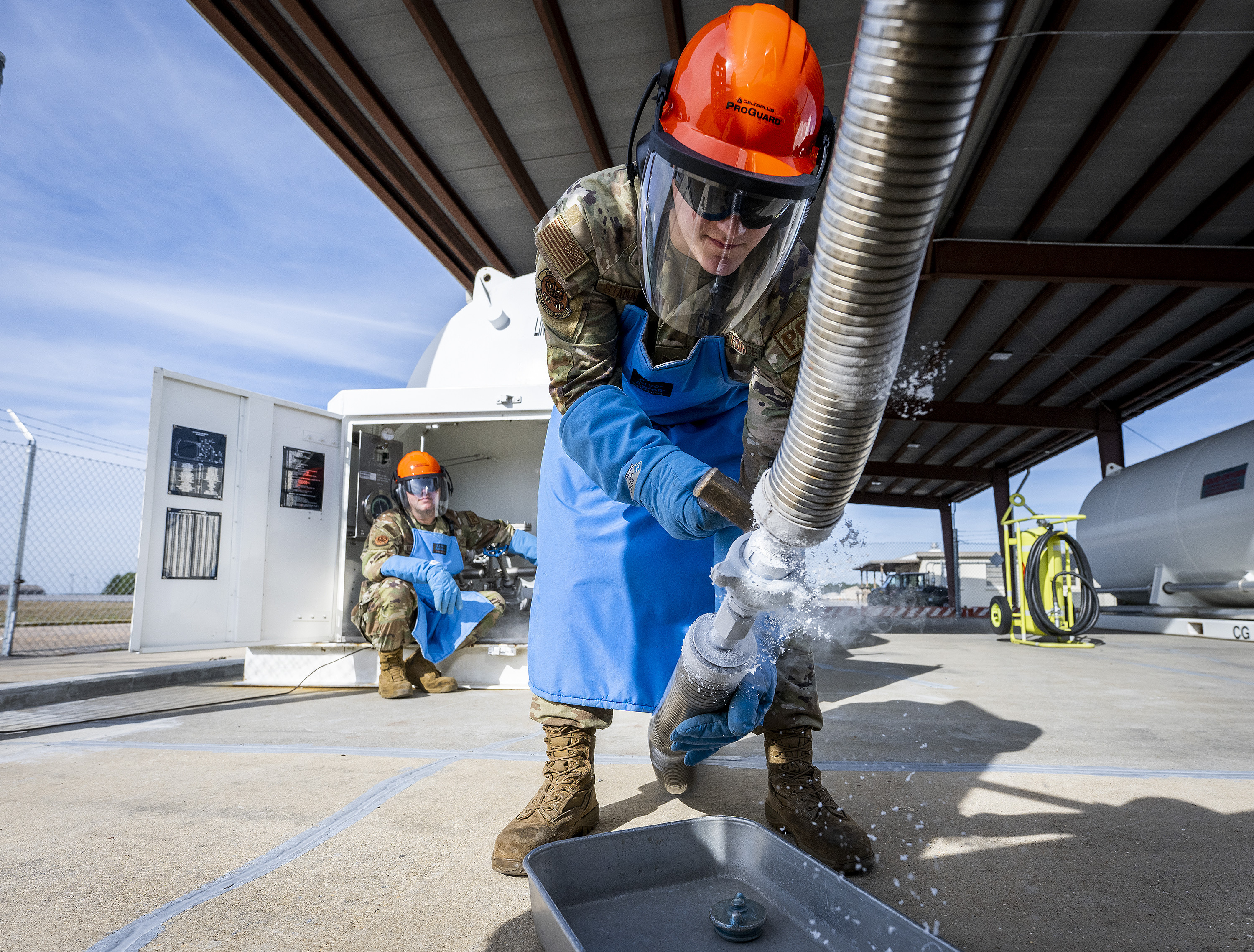Cryogenics Airmen Supply Cool Fuel for Climatic Munition Test
 During the intense heat of summer and throughout the humid Florida fall, Airmen donned protective gear to handle, manage, and deliver over 19,000 gallons of liquid nitrogen at temperatures below minus 300 degrees Fahrenheit to support a three-month munition test at Eglin Air Force Base.
During the intense heat of summer and throughout the humid Florida fall, Airmen donned protective gear to handle, manage, and deliver over 19,000 gallons of liquid nitrogen at temperatures below minus 300 degrees Fahrenheit to support a three-month munition test at Eglin Air Force Base.
The 96th Logistics Readiness Squadron’s Fuels Management Flight spearheaded this effort. To achieve this task, the Petroleum Oil's and Lubricants cryogenics team significantly increased their standard liquid nitrogen intake and delivery by more than 1,400%. Typically, the team issues an average of 2,100 gallons of liquid nitrogen over a normal three-month period for weapons tests, medical units, the fire department, and aircraft maintenance.
Airmen from the 96th Fuels Management Flight closely monitored a liquid nitrogen transfer on December 7 at Eglin Air Force Base, Florida. The team, responsible for Eglin’s cryogenic storage, experienced a remarkable 1,400% increase in both intake and output of liquid nitrogen during this three-month period due to a climatic munitions test. They issued 19,000 gallons compared to the usual 2,100 cryogenic fuels during that window.
This significant spike in service was in support of a BLU-137 Advanced Penetrator munition dynamic vibration and climatic test. Engineers exposed the munition to alternating 24-hour periods of extreme heat, reaching up to 160 degrees, and extreme cold, plummeting to minus 65.
To achieve the required cold temperature, engineers needed approximately 700 gallons of liquid nitrogen per day to cool the climatic chambers. The initial concern was whether Eglin’s liquid nitrogen supplier could handle the increased product demand with bi-weekly deliveries to the base’s 6,000-gallon cryogenic tanks, as stated by Tech. Sgt. Joshua Shafer, the Fuels Management Facilities NCO-in-charge.
With an influx of liquid nitrogen, the Fuels Management team adjusted their service time and effort to meet the test demand. They collaborated with testing engineers and the fuels servicing center to adapt a delivery schedule. The typical daily requirement of four hours of work for cryogenics extended to approximately seven during the test.
This adjustment was crucial to promptly respond to fluctuating daily inventory tank levels and scheduled servicing dictated by the engineers. The team vigilantly monitored liquid nitrogen levels and proactively requested additional product deliveries from the supplier through the fuels servicing center, ensuring a seamless response to the engineers' demands and a successful test mission.
The increased demand meant that cryogenics Airmen had more frequent direct contact with the highly volatile and dangerous liquid. Adhering to stringent safety guidelines was emphasized by Tech. Sgt. Christopher Killian, Fuels quality compliance section chief, to prevent injury and potential loss of life. Airmen wore specialized protective gear, including gloves, visors, aprons, on top of their uniforms, ensuring no part of their skin was exposed. This became more challenging during summer afternoons along Eglin’s flightline.
Senior Airman Fred Stamatatos, who administered many of the liquid nitrogen refuels during the test, highlighted the cumbersome nature of wearing additional personal protective equipment. Despite the challenges, the Airmen understood the importance of these measures for their safety and the safety of the team.
The high volumes of liquid nitrogen handled by the team compared to normal operations posed a massive undertaking. Considering the age of the cryogenic tanks, there was always a risk of component maintenance or failure. However, during the timeline, the Airmen provided the product without a single incident.
Chief Master Sgt. William Stapp, 96th LRS Fuels manager, acknowledged the pivotal contribution of the Fuels cryogenics technicians. Their efforts significantly advanced the progress of an affordable and exceptionally dependable weapons system, directly influencing the effectiveness of warfighters in the field.
Image: Senior Airman Fred Stamatatos, 96th Fuels Management Flight, begins to detach the liquid nitrogen pipes after a transfer on December 7th at Eglin Air Force Base, Florida. The Airmen in charge of Eglin’s cryogenic storage saw a 1,400% increase in their intake and output of liquid nitrogen over a three-month period due to a climatic munitions test. The team issued 19,000 gallons, compared to an average of 2,100 cryogenic fuels during that window. Credit: U.S. Air Force photo/Samuel King Jr.
Source: Eglin Air Force Base


